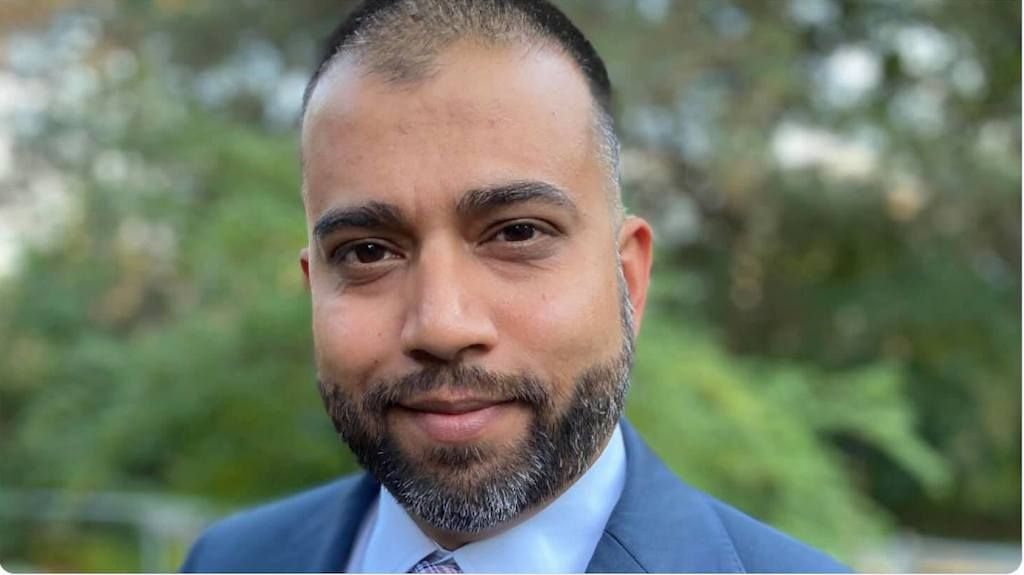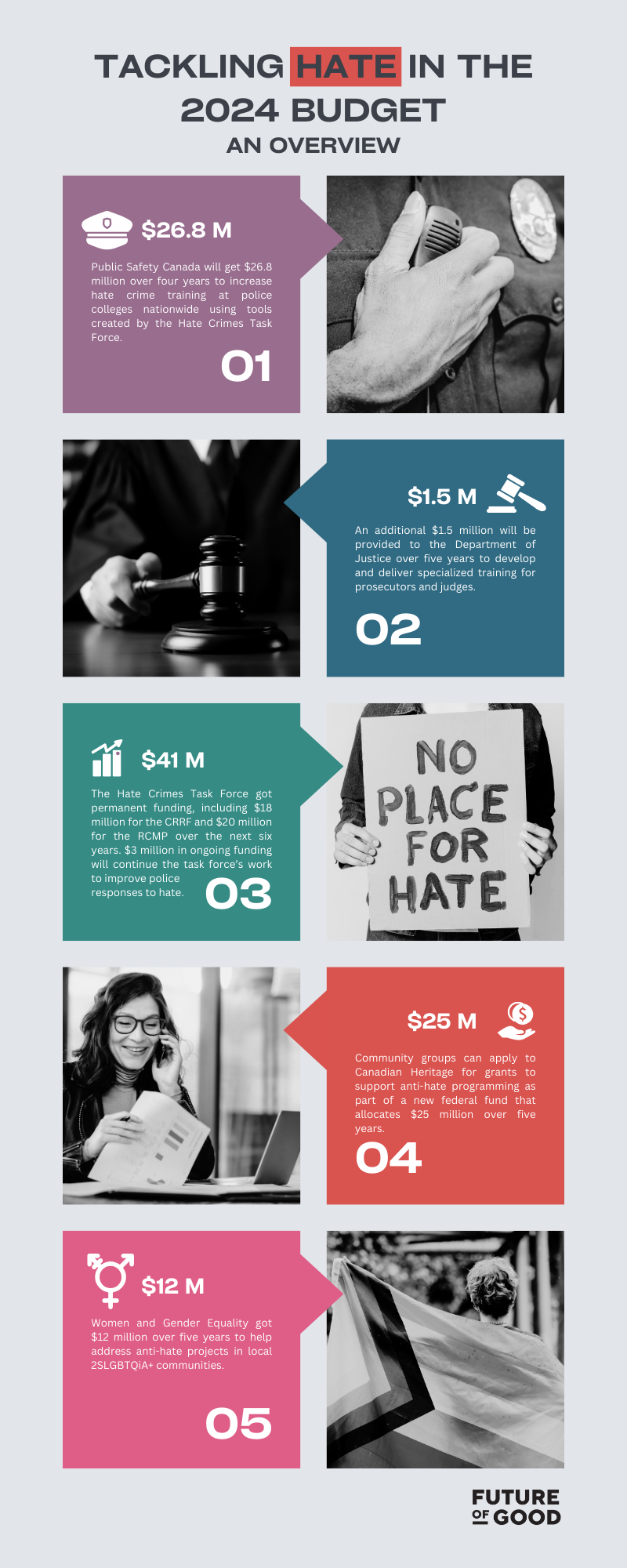Arresting hate: Foundation to educate police, justice officials on what, exactly, is a hate crime in Canada
Why It Matters
Reported hate crimes are rising rapidly nationwide, increasing by 83 per cent between 2019 and 2022, yet Canada does not have a standardized process for identifying, reporting and handling hate. This is the plan to change that.

The Canadian Race Relations Foundation says to change how hate crimes are identified, reported and handled in Canada, police departments and community leaders need to begin with a solid understanding of what constitutes hate.
Mohammed Hashim isn’t talking about defining what hate is. Instead, he means teaching others – including police, community leaders, and lawyers – a standardized legal understanding of what constitutes a hate crime.
It’s not that law enforcement doesn’t know the legal definition of a hate crime, Hashim explained; instead, the application of that definition becomes confusing to law enforcement officials.
“There are 178 different police forces across Canada, all with varying degrees of expertise and experience dealing with hate crimes and incidents,” Hashim said.
“Most police forces are local, and may or may not have had the resources to develop localized content.”
The CRRF worked with the RCMP to create national standards so that law enforcement, justice systems, and community leaders respond more effectively to hate crimes.
Law enforcement defines a hate crime as “A criminal offence committed against a person or property that is motivated in whole or in part by bias, prejudice or hate based on race, national or ethnic origin, language, colour, religion, sex, age, mental or physical disability, sexual orientation or gender identity or expression, or on any other similar factor.”
The CCRF plans to take their new standardization processes on tour to kickstart what Hashim hopes is the beginning of systemic change throughout the law enforcement and judicial communities with training for police colleges, frontline police officers, prosecutors, and community leaders.
“No organization, no committee has a degree of access that we do because we’re part of the system. ” said Hashim.
The foundation’s position as a crown corporation, a federal agency mandated to find ways to build relationships across divides, gives the foundation unique access to other federal agencies, such as the Royal Canadian Mounted Police and Public Safety Canada.
Last month, the Liberal government’s federal budget included $45 million for the CRRF —the largest sum the organization has ever received.
The budget also included $9 million in permanent annual operational funding for CRRF, a new commitment, and $3 million to create a standalone hate information hub online.
Training and education
The government’s new Online Harms Bill is one new tool that Hashim said will help educate and monitor online hate crimes.
The bill will mandate that social media companies create mechanisms to flag harmful content online and impose harsher penalties for harms such as hate speech.
Some critics argue the new bill infringes on free speech, but Hashim said the threshold for hate crimes under the Criminal Code is very high, so he is not worried about any impact on people’s freedom of speech.
Under the current system, the courts often side with protecting freedom of speech over prosecuting hate speech, said Hashim.
“That is why you see very few charges for hate speech. The vast majority of hate crime charges are mischief and some assault,” he added.
Having a better understanding of hate is crucial in reforming how police departments and judicial systems respond to hate crimes, Hashim said.
Some of this work began in 2022 when the CRRF and the RCMP created the Hate Crimes Task Force.
The task force, which included law enforcement and community leaders, identified gaps and created several tools to equip law enforcement better to prevent, investigate, and support prosecutions related to hate crimes.
New tools included a handbook for frontline police officers, an investigators’ handbook, and training for police officers in 178 police jurisdictions nationwide.
The new books draw from current resources that are already available from larger police forces that have had more significant experience and expertise, said Hashim.
The tools evolved as greater understandings in the field have been accomplished, he added.
“These are resources that didn’t exist before. We are going to be teaching police how to understand legal parameters around hate.”
Legal parameters will include looking at 20 different factors, developed in partnership with the University of Western Ontario’s law school, to consider when evaluating a hate crime.
“Let’s say that an attack happened in a place that is frequented by people of a certain demographic that was targeted, and hateful speech or graffiti was involved. So all these different things are different factors,” Hashim said.
“They’re (the legal system) agnostic to the type of victim and what they look like, so these factors are important.”
Not just police but community leaders will also be given this knowledge.
A series of new bridge-building workshops, led by Statistics Canada and the CRRF, will help community groups learn how to identify and report hate crimes. The workshops are scheduled for 12 cities across Canada.

“I am very supportive of the work the CRRF does, so am optimistic that they are able to lead through some of the work,” said Irfan Chaudhry, a hate researcher at MacEwan University in Alberta.
Chaudhry said he’s curious to see how effective the police handbooks will be, adding the handbooks should be included with training so they are not seen as an “add-on” to a police officer’s work.
“I know a few services have tried similar initiatives with low uptake from their front-line members, so it might be on how it is rolled out that will impact utility,” he said.
The standalone information hub is not operational yet but will house the knowledge it plans to share with law enforcement and communities.
The project is a massive undertaking that will take time, but Hashim is hopeful.
“That’s why we’re going on tour,” he laughed.
Hashim said the Hate Crimes Task Force will continue to identify new areas of work, and the CRRF and RCMP will respond by funding that work, whatever it may be.
“If the item is creating a new police standard – then approval is sought from the Canadian Association of Cheifs of Police, by the RCMP to have that standard be approved and adopted,” he added.
Reporting hate and supporting victims
Statistics Canada provides the only official data on hate crimes in Canada through its police-reported hate crimes reports. However, the data often lags by 15 months, making it challenging to pinpoint real-time trends, said Hashim.
The federal government will spend $12.9 million over six years to allow Statistics Canada to partner with the department of Canadian Heritage to improve how hate crimes are tracked. They also want to ensure convictions are tracked.
Canada is the only G7 country that does not track hate crime convictions.
Details about how Statistics Canada will speed up the availability of police-reported hate crime data are not yet available. Hashim said work is expected to begin in the fall.
This particular piece interests Chaudhry, who has extensively researched how hate crimes are reported and tracked and even helped create a community-led hate reporting tool in Alberta called Stop Hate AB.
“If at all, the collaboration with CRRF would speed up data release, as often StatsCan has to rely on police services to share their data via the UCR (uniform crime reporting) reporting standards— so clarity of intention and outcome on this one would need to be clear,” he said.
Police-reported hate crimes are rising steadily across Canada, with an increase of 83 per cent between 2019 and 2022.
But this data doesn’t provide a complete picture of hate. Nearly 80 per cent of hate incidents go unreported, according to the 2019 General Social Survey.
There are gaps in available data for several reasons, including the fact that not every incident is considered a crime under the Criminal Code.
Organizations that work with marginalized communities say some people do not trust the police and will not report a hate crime or incident.
Others may not know what to do when they experience a hate crime or hate incident.
Not every victim of hate will want to go through the justice system because it can be a harsh process that re-traumatizes victims, said Hashim.
“Criminal justice is the most blunt way to do resolutions. How do we support victims to actually feel whole again versus further victimized through the system?”
Many community groups collect their hate-related data and provide support for victims of hate whether or not they choose to go to the police, but they often lack the resources to keep up with demand.
In 2022, the CRRF recognized this funding gap and asked the federal government to create a national fund for organizations that support hate victims.
It outlined this request and many others in its “Reimagining a path to support all Canadians” report.
While the federal government allocated $25 million over five years to community organizations for anti-hate programming in this year’s budget, it wasn’t nearly as much as CRRF requested, including a request for ongoing funding for community organizations.
Hashim said money for hate crime victim support is a growing need.
He gave the example of London, Ont.’s Muslim community, a vulnerable group on edge during the trial of a man who was later convicted of murder, attempted murder and terrorism for deliberately driving his truck into a Muslim family on June 6, 2021.

MRCSSI staff with Mohammed Hashim in London, Ont., Canadian Race Relations Foundation
“The City of London reached out to us to ask, ‘How do we support the community?’” Hashim recalled.
The foundation was able to secure funding for a local Muslim group from Justice Canada’s Victim Fund for victim support, he said.
“The best way to support people and victims of hate is not necessarily saying go to the police and report it. It’s saying, ‘Where are you at? How can I support you?’
“That is far more meaningful to them and their sense of finding a sense of resolve and being able to see a sense of belonging. We need to invest in communities to do that,” Hashim said.
To Hashim, ‘hate’ has become a politically charged word that is sometimes used too lightly, which makes it more difficult to recognize when a hate crime is taking place.
“We want people to do this work. Understand the parameters of it. Let’s truly understand the parameters and not just on the reporting side of things but our response to it, which all need to be improved,” Hashim said.
Quick look at the budget numbers
The 2024 budget included many big-ticket items to tackle hate. Here is an overview:
- Public Safety Canada will get $26.8 million over four years to increase hate crime training at police colleges nationwide using tools created by the Hate Crimes Task Force.
- An additional $1.5 million will be provided to the Department of Justice over five years to develop and deliver specialized training for prosecutors and judges.
- The Hate Crimes Task Force also received permanent funding in 2024’s budget, including an additional $18 million for the CRRF and $20 million for the RCMP over the next six years. This will be followed by $3 million in ongoing funding to continue building on the task force’s work to improve police responses to hate.
- Community groups can apply to Canadian Heritage for grants to support anti-hate programming as part of a new federal fund that allocates $25 million over five years.
- Women and Gender Equality got $12 million over five years to address anti-hate projects in 2SLGBTQiA+ communities.

